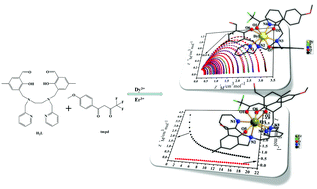Designing a mononuclear DyIII single-molecule magnet (SMM) by using a N,O,N,O-based multichelating Schiff base ligand and a β-diketonate ligand†
Abstract
Two mononuclear LnIII compounds, in which each LnIII is eight-coordinated, namely [Ln(L)(tmpd)] (Ln = Dy (1) or Er (2)), have been prepared using a multichelating Schiff base ligand N,N′-bis(2-hydroxy-5-methyl-3-formylbenzyl)-N,N′-bis-(pyridin-2-ylmethyl)ethylenediamine (H2L) and a bidentate chelating β-diketonate ligand (tmpd). The local geometry of the LnIII ions in 1 and 2 is close to the D2d symmetry. Notably, magnetic studies reveal that compound 2 displays no slow relaxation of magnetization while compound 1 exhibits single-molecule magnet (SMM) behaviour in the absence of a static magnetic field, with an effective energy barrier (Ueff) of 66.81 cm−1 (96.63 K). To deeply understand their different magnetic behaviours, the magnetic anisotropy of 1 and 2 is systematically studied by ab initio calculations. There was an obvious difference between the first excited state (KD1) and the experimental Ueff in 1 because the QTM within KD0 is not completely prohibited and the residual QTM could lead to a large discrepancy between experimentally-fitted Ueff and ab initio calculated crystal field splitting. No temperature/frequency dependence is recorded in the ac susceptibility of 2 because the ab initio magnetic easy axis of 2 does not lie close to any atom of the first sphere since it tries to avoid any strong electrostatic repulsion. Moreover, the gXY value of KD0 of 2 is larger than that of 1 by three orders of magnitude leading to the probability of stronger QTM within KD0 of 2.



 Please wait while we load your content...
Please wait while we load your content...